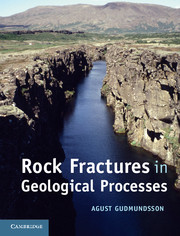Book contents
- Frontmatter
- Contents
- Preface
- Acknowledgements
- 1 Introduction
- 2 Stress
- 3 Displacement and strain
- 4 Relation between stress and strain
- 5 Loading of brittle rocks to failure
- 6 Stress concentration
- 7 Theories of brittle failure of rocks
- 8 Extension fractures and shear fractures
- 9 Displacements and driving stresses of fractures
- 10 Toughness and fracture mechanics
- 11 Field analysis of extension fractures
- 12 Field analysis of faults
- 13 Evolution of extension fractures
- 14 Evolution of faults
- 15 Fluid transport in rocks – the basics
- 16 Fluid transport in faults
- 17 Fluid transport in hydrofractures
- Appendix A Units, dimensions, and prefixes
- Appendix B The Greek alphabet
- Appendix C Some mathematical and physical constants
- Appendix D Elastic constants
- Appendix E Properties of some crustal materials
- Index
- References
9 - Displacements and driving stresses of fractures
Published online by Cambridge University Press: 05 June 2012
- Frontmatter
- Contents
- Preface
- Acknowledgements
- 1 Introduction
- 2 Stress
- 3 Displacement and strain
- 4 Relation between stress and strain
- 5 Loading of brittle rocks to failure
- 6 Stress concentration
- 7 Theories of brittle failure of rocks
- 8 Extension fractures and shear fractures
- 9 Displacements and driving stresses of fractures
- 10 Toughness and fracture mechanics
- 11 Field analysis of extension fractures
- 12 Field analysis of faults
- 13 Evolution of extension fractures
- 14 Evolution of faults
- 15 Fluid transport in rocks – the basics
- 16 Fluid transport in faults
- 17 Fluid transport in hydrofractures
- Appendix A Units, dimensions, and prefixes
- Appendix B The Greek alphabet
- Appendix C Some mathematical and physical constants
- Appendix D Elastic constants
- Appendix E Properties of some crustal materials
- Index
- References
Summary
Aims
How do we model fractures observed in the field? For example how do we determine the tensile stress that opened the fracture in Fig. 8.2 or the shear stress responsible for the vertical displacement on the normal fault in Fig. 8.1? Similarly, how can we estimate the magma overpressure that generated the dyke in Fig. 8.1? To answer these questions we need mathematical models of rock fractures. Such models are normally referred to as crack models, even though the words ‘fracture’ and ‘crack’ are often used as synonyms. The conceptual and analytical models provided in this chapter are fundamental for the remainder of the book. The main aims of this chapter are to:
Explain the three main geometric crack models used for rock fractures, namely through-the-thickness cracks, part-through cracks, and interior cracks.
Clarify further the concepts of strike dimension, dip dimension, and controlling dimension and how these are used for rock fractures.
Explain the three main modes of displacement of the fracture surfaces or walls, namely mode I, mode II, and mode III, and for which types of rock fractures each mode is most appropriate.
Explain what is meant by mixed-mode (hybrid) cracks and for which types of rock fractures these are applicable.
Provide basic formulas and numerical examples on the use of the geometric models and crack-displacement modes to estimate the driving stresses and pressures associated with rock-fracture formation and development.
- Type
- Chapter
- Information
- Rock Fractures in Geological Processes , pp. 255 - 287Publisher: Cambridge University PressPrint publication year: 2011



